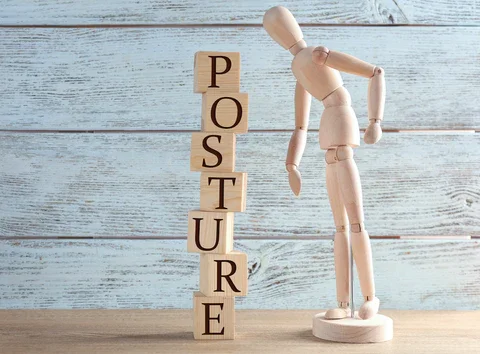Health
Are You in Pain? How Your Body Movements Help or Hurt You
July 14, 2019
Have you noticed that as you age your body seems to be a bit more… stiff? You may even be experiencing some legitimate pain: back pain, neck pain, hips, shoulders, knees, and even ankles.
In fact, most of us aren’t hurting because of injuries sustained by accidents. We appear to be hurting for no reason at all!
Well, almost no reason.
You see, we live in a flexion-based society—that is our physical body movements and overall daily habits contain a lot of bending and slouching forward. This constant unalignment of our bodies creates immense stress on our spines.
As a member of the human species, we’re meant to move in all directions, not just forwards. This failure to properly exercise the muscle groups in our bodies that hold us up against gravity has a dramatic impact on not only our spines but our entire musculoskeletal system.
I want to share with you what I’ve learned as a Doctor of Physical Therapy about the human body. I’m going to walk you through what you may be doing in your everyday life that’s causing you to be in so much discomfort and teach you what you can do to correct your behaviors and start living your best pain-free life.
Is There a Link Between Posture and Pain?

Did you know we bend forward in some way, shape, or form 3,000 to 5,000 times a day? A lifetime of this habit can make us lose the ability to look up because our bodies become molded in this flexed position.
We’re not meant to move this way! We are meant to be upright, on our feet, and in complete agreement with gravity.
Let’s take a look at some of the daily activities where you may be posturing yourself with a forward neck, rounded shoulders, and a rounded back:
- Slumped in a chair while eating.
- Driving and riding in the car with poor posture.
- Slouched in front of a computer.
- Looking down at your smartphone.
Now let’s multiply just these four activities with how many times you eat in a day, each time you’re in the car, the hours you’re sitting at a desk, and every time you look at your phone. This cycle continues day after day, month after month, and year after year until finally the occasional pain suddenly becomes chronic and unbearable.
Unfortunately, poor posture isn’t only causing us our aches and pains, it’s also affecting the overall efficiency in how our bodies develop.
Here are a few examples:
- Kyphosis
- Most common in adolescence, this can happen when the spine and the surrounding muscles develop abnormally, due to poor posture.[1]
- Herniated Disc
- Once your postural muscles begin fatiguing and your shoulders start to round forward, your head will naturally drift forward as well. This puts too much tension on your discs, ligaments, and joints in your cervical spine. For every inch your head postures forward, an additional 10 pounds of pressure are added to your spine.[2]
- Incontinence
- Slumping over increases pressure in your abdomen, which inadvertently puts pressure on your bladder. This also decreases the ability of your pelvic floor muscles to hold against that pressure.
- Constipation
- Poor posture while on the toilet somewhat closes the anus, making it more difficult for your abdominal muscles to push the feces out.
- Heartburn
- Slouching after a meal can cause the acid in your stomach to go in the wrong direction, due to the abdominal pressure. This acid reflux can then trigger heartburn.[3]
- Anxiety and Depression
- Continuous poor posture over time can make you feel heavy and achy, which leads to being tired and irritable. It’s also been proven in studies that carrying yourself in more of an upright position, with your shoulders back, projects a confident persona.[4]
- Headaches
- When you lean forward or slouch, you often clinch your jaw without realizing it. This subsequently tightens the muscles in your face causing headaches and jaw pain.
- Lung function
- Poor posture impacts how much air you are taking into your lungs when inhaling. This doesn’t only have a negative impact on your lungs, but the other vital organs you have, such as your heart and brain, that rely on proper oxygenation.[5]
Can Bad Posture be Corrected?
Yes! Absolutely.
However, those with long-standing issues will have a longer road in correcting their posture because their joints have more than likely adapted.
With the proper exercises and becoming consciously aware of your posture while sitting, standing, and laying down, this will gradually help you to improve and replace your current posture.
Here are some tips on how you should be positioning your body: [6]
- Avoid crossing your legs.
- Put your feet on a footrest if they don’t reach the floor.
- Prevent yourself from sitting in the same position for long periods of time.
- Position your feet shoulder-width apart.
- Tuck your stomach in.
- Stand tall with your shoulders pulled back.
- Find the right mattress.
- Sleep with a pillow.
- Use a pillow between your legs if sleeping on your side.
- Avoid sleeping on your stomach.
The Healing Benefits of Exercise

We are creatures that are meant to move!
The way we move on a daily basis can help prevent pain, degenerative disease, and improve our physical, mental, and emotional states.
Many of the physical pains we experience each day could be avoided and possibly fixed if we just started moving the other way, improve our sitting postures, and exercise in a way that will strengthen the backsides of our bodies.
This process involves not only personal awareness but also taking part in the appropriate stretches, doing posterior core exercises, and strengthening the muscles that hold you up.
Conventional thinking tells us that we need to log long hours on treadmills, bikes, and ellipticals. We are told to do at least 30 minutes of cardio every day and to make sure you have a device to count the calories burned. These exercises do little for the functional strength or mobility needed in our daily lives.
Exercising with short, intense bursts and using functional movements will yield incredible results. We should look forward to the physical expression of our bodies!
The best exercises to generate the most power are:
- Lifting weights
- Sprinting
- Walking
- Yoga
Yoga is very popular in our society today! Here are a few yoga poses for beginners you can do at home: [7]
- Extended Mountain Pose
- Crescent Lunge (with arms)
- Cat/Cow
- Bridge
- Bound Warrior
So, how do these exercises actually help your posture? Let’s take a look: [8]
- They strengthen your core
- Your abdominal and lower back muscles work to stabilize your lower torso, which keeps your spine upright. Your thighs and buttocks keep your hips aligned.
- Your upper body becomes balanced
- If one side of your body is stronger than the other, your bones will be pulled out of alignment by your muscles, negatively affecting your posture. Your upper body keeps your neck, shoulders, and head in their proper positions.
Feeling Better is Only a Few Movements Away
It’s amazing how we’ve unknowingly been doing so much damage to our bodies by just living our lives. How the simple act of how we sitting or looking at our phones can harm our musculoskeletal systems and even internal organs!
I have created the NativeBody Reset that is designed to relieve discomfort, build your core strength, and improve your overall mobility.
This program walks you through simple daily-move routines that will improve pain in your neck, back, shoulders, and hips while improving overall core strength and body mobility. There is no equipment needed and you can do it all from the comfort of your own home!
You are only 30 days away from living your best life!

Medical Disclaimer
This content is for informational and educational purposes only. It is not intended to provide medical advice or to take the place of such advice or treatment from a personal physician. All readers/viewers of this content are advised to consult their doctors or qualified health professionals regarding specific health questions. Neither Dr. Chad Walding nor the publisher of this content takes responsibility for possible health consequences of any person or persons reading or following the information in this educational content. All viewers of this content, especially those taking prescription or over-the-counter medications, should consult their physicians before beginning any nutrition, supplement, or lifestyle program.


